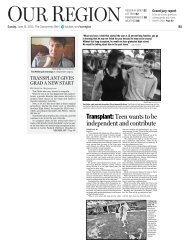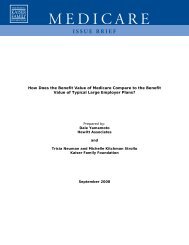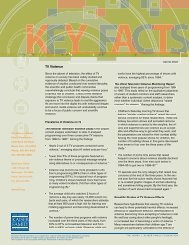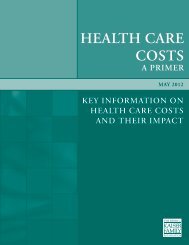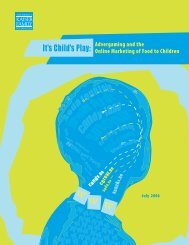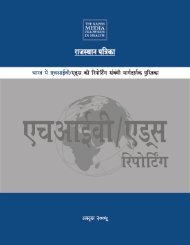Sex Ed Issue Update.indd - The Henry J. Kaiser Family Foundation
Sex Ed Issue Update.indd - The Henry J. Kaiser Family Foundation
Sex Ed Issue Update.indd - The Henry J. Kaiser Family Foundation
Create successful ePaper yourself
Turn your PDF publications into a flip-book with our unique Google optimized e-Paper software.
According to the 2000 Federal School Health <strong>Ed</strong>ucation Profi les<br />
study, the median percentage of schools off ering required<br />
health education courses to students in grades 6 to 12 was 91<br />
percent. Among these schools, a large percentage said that<br />
they tried to increase knowledge of HIV (96%) and pregnancy<br />
prevention (84%). 6<br />
Federal Policy<br />
HIV/AIDS <strong>Ed</strong>ucation<br />
In response to the public health threat presented by the AIDS<br />
epidemic, the Centers for Disease Control and Prevention (CDC)<br />
has provided funding and technical assistance specifi cally<br />
for HIV education since 1988. 7 In 2000, the CDC budgeted<br />
approximately $47 million for in-school HIV education, which<br />
is just one piece of its larger prevention eff orts. In-school HIV<br />
education funds are directed toward strengthening national<br />
eff orts for coordinated school health education, training<br />
180,000 teachers annually in eff ective strategies for HIV/STD<br />
education, as well as supporting HIV education for youth in 48<br />
states, U.S. territories, the District of Columbia, and 18 major<br />
cities. 8 Ohio and Utah are the only states that do not accept HIV<br />
education funding from the CDC.<br />
Most of the CDC funding for in-school HIV education goes<br />
toward the education of students in high schools or middle<br />
schools, although some money goes toward HIV education<br />
eff orts aimed at college students and at-risk youth who are not<br />
in schools. Most of the recipients are state and local education<br />
agencies, although other national organizations receive funds<br />
as well. Programs and schools that receive the CDC funding<br />
must agree to have their curriculum reviewed by a committee<br />
which is supposed to follow the Guidelines for Eff ective<br />
School Health <strong>Ed</strong>ucation to Prevent the Spread of AIDS, which<br />
recommend a comprehensive curriculum. 9<br />
Abstinence-only <strong>Ed</strong>ucation<br />
Federal support for abstinence-only education eff orts began<br />
in 1981 with passage of the Adolescent <strong>Family</strong> Life Act (AFLA),<br />
whose primary stated goal is to prevent premarital teen<br />
pregnancy by establishing “family-centered” programs to<br />
“promote chastity and self discipline.” 10 It also seeks to promote<br />
adoption as the preferred option for pregnant teens and to<br />
provide support services for adolescents who are pregnant or<br />
parenting. In AFLA’s fi rst year, Congress authorized $11 million<br />
to be spent, in part, on promoting abstinence. Since then, the<br />
program has been refunded annually at between $6 and $18<br />
million, 11 with last year’s appropriation providing $12 million for<br />
the eff ort. 12<br />
A much more substantial amount of funding for abstinenceonly<br />
education was allocated in 1996 under the auspices of the<br />
Personal Responsibility and Work Opportunity Reconciliation<br />
Act, welfare reform legislation best known for the sweeping<br />
revisions it made to public assistance programs (including<br />
replacing the Aid to Families with Dependent Children—<br />
AFDC—with a new program, Temporary Assistance to Needy<br />
Families, TANF).<br />
<strong>The</strong> omnibus bill, which amended portions of Title V of the<br />
Social Security Act, provided $250 million in federal funds to the<br />
states allocated over a fi ve-year period (fi scal year 1998 through<br />
fi scal year 2002) to support abstinence-only programs, for both<br />
teens and unmarried adults.<br />
To qualify for Title V money, states must match every four<br />
dollars in federal funds with three dollars of state money,<br />
thus directing as much as $437.5 million to abstinence-only<br />
programs by the time the initial funding cycle ended in the fall<br />
of 2002. <strong>The</strong> legislation also provides a detailed defi nition of<br />
what federally funded programs are expected to teach (Table<br />
1).<br />
In 2000, Congress approved a separate abstinence-only “setaside”<br />
for community organizations as part of the maternal and<br />
child health block grants. <strong>The</strong>se “Special Projects of Regional<br />
and National Signifi cance Community-Based Abstinence<br />
<strong>Ed</strong>ucation” (SPRANS) initially received $40 million in earmarked<br />
funds over a two-year period. 13 Under SPRANS, grants are<br />
awarded directly by a federal agency, not by governors or state<br />
agencies; it also does not require that local funds match federal<br />
donations, thus potentially allowing greater access to the funds.<br />
Congress is expected to renew funding for all three of the<br />
current federal abstinence-only initiatives during the fi scal year<br />
2003 appropriations process, particularly given President Bush’s<br />
strong support of these programs. In fact, abstinence-only<br />
advocates have urged the President to hold to his promise to<br />
provide as much federal funding for abstinence programs as is<br />
provided to family planning programs that serve adolescents,<br />
which some estimate received $135 million in fi scal year 2001. 14<br />
Table 1<br />
Defi nition of “Abstinence”<br />
Under federal law, abstinence funds are available only to those<br />
programs that teach:<br />
§ Abstinence has social, psychological, and health benefi ts<br />
§ Unmarried, school-age children are expected to abstain<br />
from sex<br />
§ Abstinence is the only certain way to prevent out-ofwedlock<br />
pregnancy and sexually transmitted diseases<br />
§ A mutually faithful and monogamous married<br />
relationship is the standard for sexual activity<br />
§ <strong>Sex</strong>ual activity outside marriage is likely to have harmful<br />
psychological and physical eff ects<br />
§ Out-of-wedlock childbearing is likely to harm a child, the<br />
parents, and society<br />
§ How to reject sexual advances and how alcohol and drug<br />
use increases vulnerability to them<br />
§ <strong>The</strong> importance of attaining self-suffi ciency before<br />
engaging in sex<br />
Source: Section 510 (b), Title V of Social Security Act.



